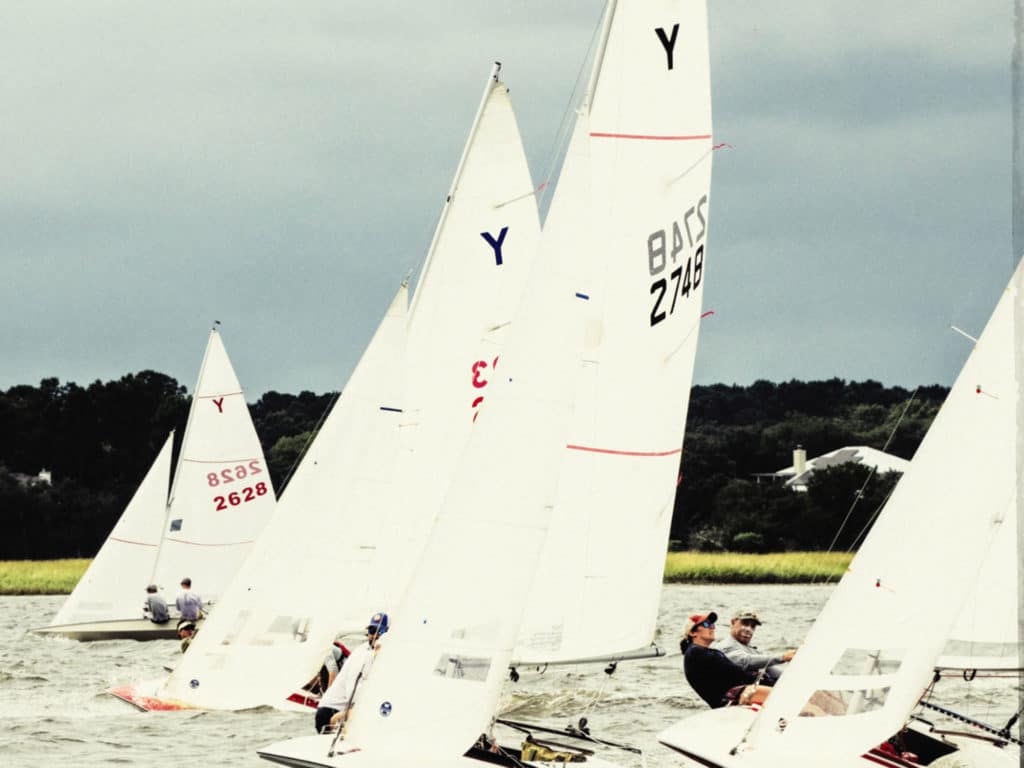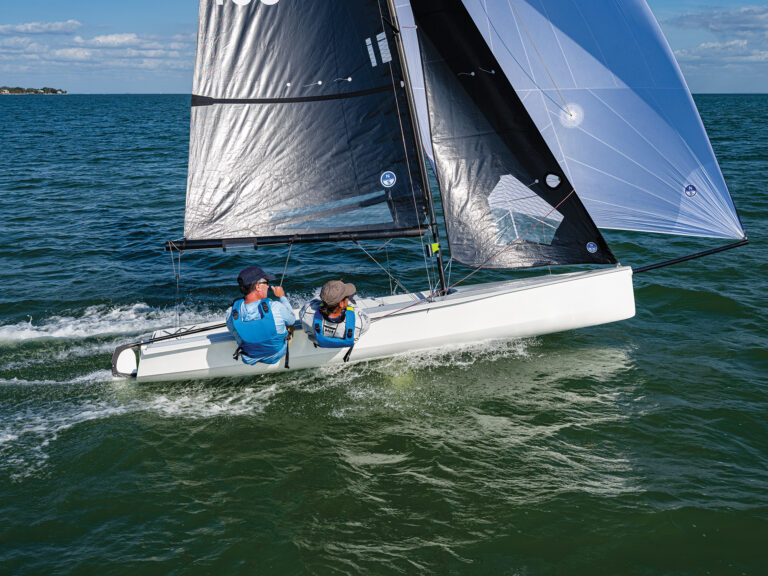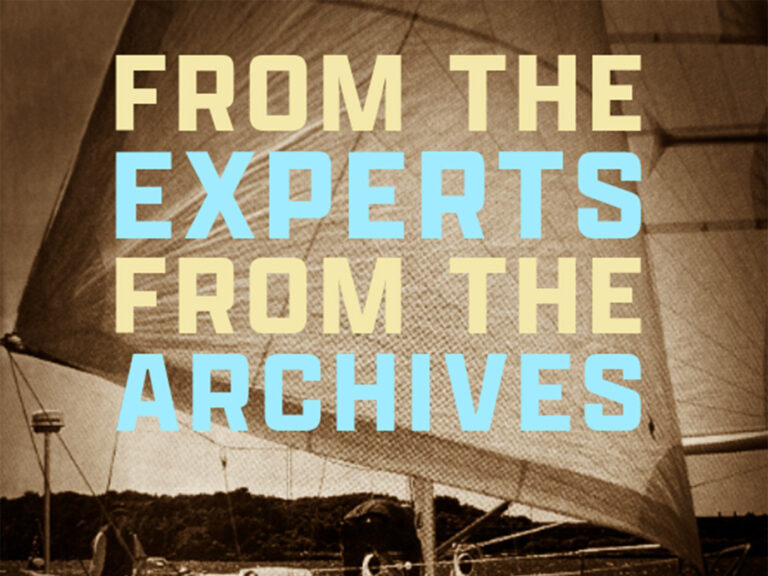
If a formula exists for supercharging activity in a one‑design fleet, Ned Goss appears to have discovered it. Though he’s only been active in the Y-Flyer Class for a few years, his efforts to bolster turnout at a local regatta in Charleston, South Carolina, 18 months ago sparked a movement. Since then, local participation has trebled, and a new class builder has come forward with six boats on order and more to come.
So, how does a former pro sailor and speed merchant—Goss documented 36.5 knots aboard his Mach 2 Moth one afternoon in 2014 on Charleston Harbor, making him the fastest Moth sailor in the world—suddenly become the spark plug for an 80-year-old one-design class? As unlikely as that progression seems, it’s a morality tale for the sport—all about fun and family.
Designed in 1938 by Alvin Youngquist, of Toledo, Ohio, the uniquely identifiable Y-Flyer is an 18-foot hard-chined, scow-shaped, two-person dinghy with fleets active throughout the southeastern, Midwestern, and northeastern US. There are pockets in Canada as well. Originally designed to be built at home out of plywood, the majority of Y-Flyers active today are molded in fiberglass. Fully rigged, these boats customarily weigh around 500 pounds (the class-required minimum weight) and carry a single-spreader mast supporting 161 square feet of sail area in a main and a jib. The Y-Flyer Class Association advertises its craft as “fun, versatile and family-oriented.” It turns out, those are exactly the qualities that galvanized Goss’ interest.
Some people are described as a bundle of energy. Goss, a Connecticut-native-cum-South-Carolinian, is the exponential extension of that. He’s hyperkinetic, perpetually on the move. In Charleston, at the James Island YC Y-Flyer and Friends Regatta this fall—an event he co-founded—Goss drove the tractor to launch and haul boats while discussing equipment refinements with fellow competitors and alternately using his phone to manage the coming week’s schedule of sailing classes, exams and maintenance work at the College of Charleston’s sailing center, where he serves as dockmaster, head instructor and offshore sailing coach.
At 44, Goss has been sailing and sailboat racing most of his life. He’s bounced from Blue Jays to 420s, Fireballs, 49ers, Melges 24s, foiling Moths, and an assortment of keelboats. Throughout his time in this sport, he’s experienced periods that could best be described as burnout. And each time after a hiatus away from racing, he’s returned to competitive sailing with renewed energy.
“I’ve had a couple of episodes in my life,” he explains, “where the sailing I was doing became overly intense. In those moments, I just had to step away from the sport. And each time, after some reflection, I realized that the fun had gone out of it. I know now that what I really love is sailing with people. Sailing alone like you do in the Moth class just doesn’t satisfy me in a sustainable way. I love being around others who love sailing and openly sharing what they learn. In our Y-Flyer fleet, after every regatta we sit down and talk, and the newer competitors learn from the more seasoned Y sailors. That’s basically the ethos of this class. It really adds to the fun of racing, and it allows everyone to get better.”
This is exactly what Charleston’s Y-Flyer cohort experienced recently, and it all seems to trace back to one phone call.

In the weeks leading up to the 2020 edition of the James Island Open Regatta—a summertime staple—Goss determined that he and his wife, Jessica, would race their Y-Flyer. He’d had the boat for several years but only raced it occasionally.
“At the time,” Goss recalls, “I was looking for a two-person boat that wasn’t too technical so I could compete in it with my wife, who is a relative newcomer to the sport. We had the Y-Flyer, so that’s what we registered for the regatta.”
The problem was, only one other entry materialized in that class. That was about when Goss got a call from Jeff Woodard. He was a Hobie 20 racer, but local participation in that class had recently faltered. So, Woodard wondered if Goss could locate a Y-Flyer that he and his wife, Amy, could race in the regatta. As Goss tells the story, he got busy on the phone, and in little time he’d found four available boats.
“Bob Turner, who is the Y-Flyer class president, had an extra boat that he agreed to loan out,” Goss explains, “and I found three others. It wasn’t a problem finding people to race them because COVID had shut down so many sailing events that everyone was eager to get back on the water. Right out of the gate, we had eight boats registered for the regatta, and I think seven crews ended up competing. Half that fleet had never sailed a Y-Flyer before.”
That was the turning point. The momentum continued when the fleet began participating in the James Island Yacht Club’s weekly summer evening series. With four boats available each week as loaners, a number of different individuals got the chance to sample Y-Flyer racing over that summer. Sensing a chance to really spread the word, the Gosses did their best to connect these opportunities with local influencers, like Greg Fisher and Kevin Jewett, the former and current directors of the College of Charleston’s sailing program.

After one Thursday evening sailing with his wife, Jo Ann, Fisher seemed genuinely enthused. “It’s really exciting to see the rebirth of the Y class here in Charleston,” he says. “I think it’s the perfect boat to involve all levels and ages of sailors, and it seems like the class here has a great group of people working hard to help and encourage new participants. Jo Ann and I had a super time enjoying the fun, quick racing out there tonight. We’re actually talking about buying our own boat and getting involved full time.”
The fun that Fisher cites turned out to be infectious, and in short order, other local influencers got involved as well. Three-time Sunfish world champion David Loring actually grew up sailing Y-Flyers in Charleston, so he found a boat and joined in. And so did Will Hanckel, who took his first ride on a Y-Flyer at age 3 and can’t remember a time that there wasn’t one sitting in the family driveway. (Loring and Hanckel are both former junior and adult national champions in this class.)
And local one-design legend Lenny Krawcheck gravitated back to the class as well. As a teenager, he was the Y-Flyer junior national champion in 1959, and later won the national championship twice (’82 and ’94). For him, this resurgence in activity was almost nostalgic. Krawcheck recalls an era when there were 30-plus Y-Flyers racing regularly in Charleston.
Throughout the subsequent fall and winter—customarily Charleston’s offseason—Goss and company kept the momentum humming by orchestrating a series of one-day regattas. In the aggregate, all of this activity didn’t go unnoticed. Jessica Goss was documenting it for the Y-Flyer class website with regular updates, and others, like the aforementioned Turner—the class president—were promoting it elsewhere. So, it wasn’t surprising that Charleston’s contingent was able to convince the national class officers to have the Y-Flyer molds shipped from New England down to Charleston, where Kurt Oberle, of High and Dry Boatworks, had agreed to become the new builder.

Oberle—more custom fabricator than boatbuilder—didn’t want to build the boats conventionally. What really cemented his interest in becoming the official class builder was the opportunity to implement a resin-infusion process.
“We’ve been working with infusion guru Phil Steggall from MJM Yachts,” Oberle explains. “Peter Johnstone was kind enough to loan him for this project. The toughest part has been setting up 30-year-old molds to work with resin infusion. At the moment, we’re sourcing all the materials to get started on the first boat. We’ve got six boats on order, and there’s potentially enough demand that we’ll build another six by the end of next year.”
Part of that demand is being driven by locals like David Hood, who borrowed a boat and raced most of the past summer with his two daughters—Saylor, 8, and Harbor, 6. Putting his boat away at the James Island YC after a breezy last day of the Y-Flyer and Friends Regatta, Hood seemed quite pleased.
“This is our first year in the Y,” he says, “and I’ve learned that it’s a pretty easy platform for a family like ours. I’ve raced Lightnings for years, but I think that boat would be too much for the girls right now. The Y is fun, and they seem to love it. It’s just so easy to get here, set up the rig, get the boat in the water, and 15 minutes later, we’re racing.”
What Hood identifies is a key aspect of the Y-Flyer’s longevity—its simplicity. That element means these boats are accessible to a wide array of sailors. The Y-Flyer can accommodate not just a broad spectrum of combined crew weights, but also a wide range of racing talent. Of the 13 boats on the water at this event, five were raced by family crews, and six had both males and females on board. But perhaps the most telling metric of all is the fact that the competitors’ ages ranged from 6 to 80.
Come June, the Y-Flyer National Championship regatta will take place on Lake Norman, North Carolina, a mere three hours up the road from Charleston. Goss intends to rally at least half a dozen Lowcountry boats to make the trip. Ideally, he says, all of them will place in the top 10. Regardless, he knows the ultimate measure won’t be trophies won; it will be in fun had. And that’s just how it ought to be in this sport.









